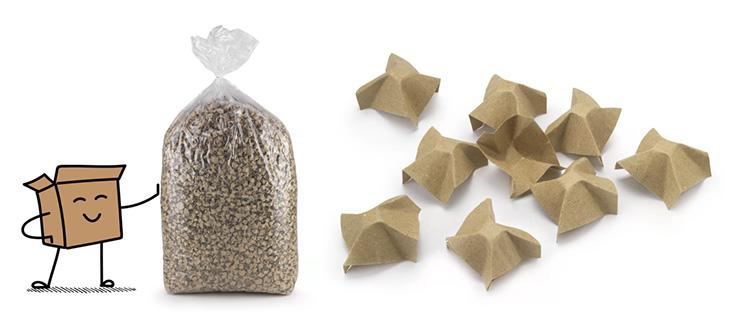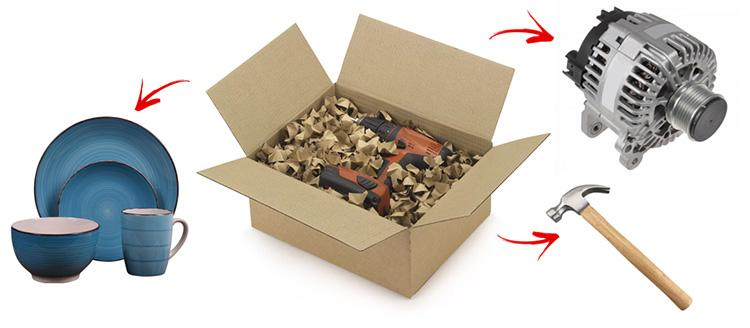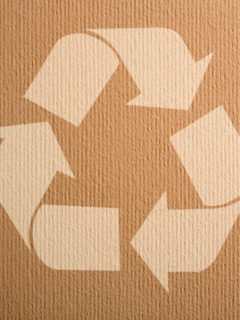Protecting your product is a crucial step in the packaging process. As a shipper, you naturally want your products to stay in place and arrive intact at their final destination. Cushioning products come in all shapes and sizes. The most popular ones are not always the most environmentally friendly, as they are not always easy to recycle. It is time to find a solution. That’s why RAJA is introducing a completely new type of cushioning: paper cushioning particles. These particles combine many of the best properties of other materials. Environmentally friendly, protective and elegant: paper dunnage particles have it all!
1. What are paper dunnage particles?
Paper dunnage particles are easily compared to polystyrene (or starch) particles in terms of their shape and application. You can easily pour the particles into a box to fill the empty spaces around your product. The shape of the particles makes them stick together so that your products stay in place and do not move. The particles allow your products to have a cushion to absorb the biggest shocks. The perfect cushioning and shock absorber!
What makes them unique is that they are made of paper: a renewable resource. Paper is derived from wood, and wood comes from trees. We can let these trees grow and renew themselves ad infinitum, without putting pressure (or at least much less) on raw material reserves and the climate. For RAJA’s paper padding particles, we specifically used testliner, which is actually recycled paper. This way, we did not have to use any new trees to manufacture this product.
How should the end customer sort out this type of cushioning? Unlike some other materials (polystyrene or starch), it is very clear here. The paper particles should be disposed of in the cardboard box: it’s that simple! As an online shop, this adds to the customer satisfaction who will more easily order a second, third or fourth time.

2. What are the benefits of paper cushioning particles
These dunnage chips are a perfect blend of some of the best properties of other dunnage materials. They are very easy to use, very strong, stylish and, most importantly, environmentally friendly. Below we look at the practical benefits they offer to packers and recipients.
2.1 Benefits to the packer (company)
- Protection and strength:If you run an online shop, you want to waste as little time as possible in the packing process. The material you use should be easy to handle and reliable. Fortunately, there are paper packing particles! First of all, they are very strong and dimensionally stable. When poured into your crate, the chips adhere firmly to each other. They form a strong protective layer around your products. Even heavy items (such as porcelain, car parts or electrical appliances) can be placed on the chips without any problems. Good to know: because they retain their shape, they can be reused several times. A good thing for the environment.
- Save time: secondly, the chips save you a lot of time at the packing table. They are pre-folded to the right shape and can easily be spread out in a box. So, unlike dunnage or embossed paper, you don’t have to waste time cutting a sheet to size and folding it beforehand. Just pour the chips into the crate and you’re done! You will see that they will automatically and efficiently fill all the corners of your packaging.

Do you ship products with fragile surfaces (e.g. glass or lacquered)? In this case, it is best to pack your product with extra protection. For example, you can opt for a soft silk paper. This way, there is no risk of your products getting scratched.
2.2 Benefits to the recipient (consumer)
- Environmentally friendly: the end customer can easily recycle the cushioning particles with the rest of the cardboard packaging. So, unlike traditional foam or starch chips, your customers no longer have to worry about where and how to sort them. All in the paper and cardboard. The particles can then easily be recycled back into packaging materials.
- Elegant: its origami-like shape is often associated with notions of'originality and'ecology. They therefore contribute to a promising unboxing experience and a positive ecological experience of your brand. This is not unimportant in a digital world where packaging is often the only point of contact between an online shop and its customers.
3. How to use paper dunnage particles
In the video below, you can see, step by step, how to best use these dunnage particles. Whether you are shipping a medium, heavy or fragile product: these particles retain their functionality under all circumstances. After use, consumers can reuse the chips (because they still retain their shape) or sort them into cardboard. It’s that simple!
4. Why is RAJA launching this new product?
With the launch of these paper cushioning particles, RAJA is taking another step towards its “circular strategy”. What does this mean in concrete terms? At RAJA, we don’t see packaging as a disposable product, but rather as a circular product. In this respect, the packaging of today is the basis for the packaging of tomorrow. To achieve this, we need to learn to use other raw materials and to make better use of the sorting process. These particles do just that. They are made from a renewable raw material and can easily be sorted with the paper and cardboard after use. They form the basis for a new packaging material. And the circle is complete!
At RAJA, we strive to offer a sustainable alternative to any conventional packaging. In the past we have introduced paper tape (as an alternative to plastic tape). Then came paper bubble wrap and paper stretch wrap. The aim is to offer our customers the possibility of packaging entirely with one material, in this case paper. This makes the subsequent recycling process much simpler and 'clearer' and is an important step in creating a circular economy.
Wim Gielis, Product Program Manager RAJA Benelux













